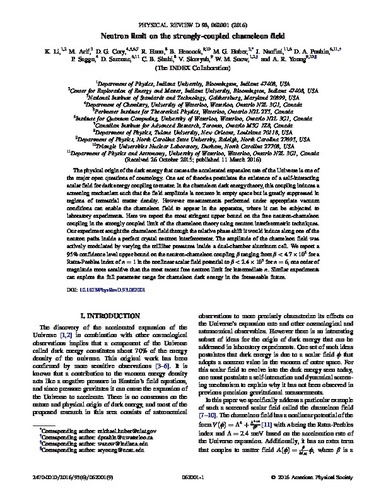| dc.contributor.author | Li, Ke | |
| dc.contributor.author | Arif, Muhammad | |
| dc.contributor.author | Cory, David G. | |
| dc.contributor.author | Haun, Robert | |
| dc.contributor.author | Heacock, Benjamin | |
| dc.contributor.author | Huber, Michael G. | |
| dc.contributor.author | Nsofini, Joachim | |
| dc.contributor.author | Pushin, Dimitry A. | |
| dc.contributor.author | Saggu, Parminder | |
| dc.contributor.author | Sarenac, Dusan | |
| dc.contributor.author | Shahi, Chandra B. | |
| dc.contributor.author | Skavysh, Vladimir | |
| dc.contributor.author | Snow, W. Michael | |
| dc.contributor.author | Young, Albert R. | |
| dc.date.accessioned | 2018-09-11 19:41:16 (GMT) | |
| dc.date.available | 2018-09-11 19:41:16 (GMT) | |
| dc.date.issued | 2016-03-11 | |
| dc.identifier.uri | https://dx.doi.org/10.1103/physrevd.93.062001 | |
| dc.identifier.uri | http://hdl.handle.net/10012/13794 | |
| dc.description | © 2016 American Physical Society, https://dx.doi.org/10.1103/physrevd.93.062001 | en |
| dc.description.abstract | The physical origin of the dark energy that causes the accelerated expansion rate of the Universe is one of the major open questions of cosmology. One set of theories postulates the existence of a self-interacting scalar field for dark energy coupling to matter. In the chameleon dark energy theory, this coupling induces a screening mechanism such that the field amplitude is nonzero in empty space but is greatly suppressed in regions of terrestrial matter density. However measurements performed under appropriate vacuum conditions can enable the chameleon field to appear in the apparatus, where it can be subjected to laboratory experiments. Here we report the most stringent upper bound on the free neutron-chameleon coupling in the strongly coupled limit of the chameleon theory using neutron interferometric techniques. Our experiment sought the chameleon field through the relative phase shift it would induce along one of the neutron paths inside a perfect crystal neutron interferometer. The amplitude of the chameleon field was actively modulated by varying the millibar pressures inside a dual-chamber aluminum cell. We report a 95% confidence level upper bound on the neutron-chameleon coupling beta ranging from beta < 4.7 x 10(6) for a Ratra-Peebles index of n = 1 in the nonlinear scalar field potential to beta < 2.4 x 10(7) for n = 6, one order of magnitude more sensitive than the most recent free neutron limit for intermediate n. Similar experiments can explore the full parameter range for chameleon dark energy in the foreseeable future. | en |
| dc.description.sponsorship | National Institute of Standards and Technology | en |
| dc.description.sponsorship | U.S. Department of Commerce | en |
| dc.description.sponsorship | National Science Foundation: PHY-1068712, NSF PHY-1205342, PHY-1307426 | en |
| dc.description.sponsorship | U.S. Department of Energy: DE-FG02-97ER41042 | en |
| dc.description.sponsorship | Canada Excellence Research Chairs, Government of Canada | en |
| dc.description.sponsorship | NSERC CREATE | en |
| dc.description.sponsorship | DISCOVERY | en |
| dc.description.sponsorship | Indiana University Center for Spacetime Symmetries | en |
| dc.description.sponsorship | Indiana University Faculty Research Support Program | en |
| dc.language.iso | en | en |
| dc.publisher | American Physical Society | en |
| dc.subject | dark-energy | en |
| dc.subject | constraints | en |
| dc.subject | supernovae | en |
| dc.title | Neutron limit on the strongly-coupled chameleon field | en |
| dc.type | Article | en |
| dcterms.bibliographicCitation | Li, K., Arif, M., Cory, D. G., Haun, R., Heacock, B., … Huber, M. G. (2016). Neutron limit on the strongly-coupled chameleon field. Physical Review D, 93(6). doi:10.1103/physrevd.93.062001 | en |
| uws.contributor.affiliation1 | Faculty of Science | en |
| uws.contributor.affiliation2 | Physics and Astronomy | en |
| uws.typeOfResource | Text | en |
| uws.typeOfResource | Reviewed | en |
| uws.peerReviewStatus | Reviewed | en |
| uws.scholarLevel | Faculty | en |

